Restrictive Effects of Water Scarcity on Urban Economic Development in the Beijing-Tianjin-Hebei City Region
Abstract
:1. Introduction
2. Background of BTH
3. Data and Methodology
3.1. Data
3.2. Methodology
3.2.1. Calculation of Shadow Price for Production Water
| Algorithm 1 |
3.2.2. Estimation of Economic Loss Caused by Water Scarcity
4. Results
4.1. Water Scarcity in the BTH City Region Based on an Assessment of Water Shadow Price
4.2. Potential Economic Loss of Water Scarcity in the BTH City Region
5. Discussion
5.1. Trends of Shadow Prices of Production Water in BTH Cities
5.2. Water Scarcity is Underestimated in the BTH City Region
5.3. Agricultural Water Saving in Hebei is Key to Solving Water Scarcity in the BTH City Region
6. Conclusions
Author Contributions
Funding
Conflicts of Interest
Appendix A

Appendix B
References
- Xie, Y.L.; Xia, D.X.; Ji, L.; Huang, G.H. An inexact stochastic-fuzzy optimization model for agricultural water allocation and land resources utilization management under considering effective rainfall. Ecol. Indic. 2018, 92, 301–311. [Google Scholar] [CrossRef]
- Fan, Y.R.; Huang, W.W.; Li, Y.P.; Huang, G.H.; Huang, K. A coupled ensemble filtering and probabilistic collocation approach for uncertainty quantification of hydrological models. J. Hydrol. 2015, 530, 255–272. [Google Scholar] [CrossRef]
- Abdulbaki, D.; Al-Hindi, M.; Yassine, A.; Abou Najm, M. An optimization model for the allocation of water resources. J. Clean. Prod. 2017, 164, 994–1006. [Google Scholar] [CrossRef]
- Yu, S.; Lu, H. An integrated model of water resources optimization allocation based on projection pursuit model—Grey wolf optimization method in a transboundary river basin. J. Hydrol. 2018, 559, 156–165. [Google Scholar] [CrossRef]
- Wikipedia Contributors. World Water Assessment Programme; Wikipedia: 2019. Available online: http://www.unesco.org/new/en/natural-sciences/environment/water/wwap/ (accessed on 15 January 2019).
- Albiero, D.; Silva, M.D.D.; Melo, R.; Garcia, A.P.; Praciano, A.C.; Fernandes, F.B.; Monteiro, L.D.A.; Chioderoli, C.; Silva, A.O.D.; Filho, J.D.B. Economic Feasibility of Underwater Adduction of Rivers for Metropolises in Semiarid Coastal Environments: Case Studies. Water 2018, 10, 215. [Google Scholar] [CrossRef]
- Nechifor, V.; Winning, M. Global Economic and Food Security Impacts of Demand-Driven Water Scarcity—Alternative Water Management Options for a Thirsty World. Water 2018, 10, 1442. [Google Scholar] [CrossRef]
- Roson, R.; Damania, R. The macroeconomic impact of future water scarcity: An assessment of alternative scenarios. J. Policy Model. 2017, 39, 1141–1162. [Google Scholar] [CrossRef]
- National Bureau of Statistics of China. China Statistical Yearbook 2018; China Statistical Press: Beijing, China, 2018.
- Wang, Y.; Bian, Y.; Xu, H. Water use efficiency and related pollutants’ abatement costs of regional industrial systems in China: A slacks-based measure approach. J. Clean. Prod. 2015, 101, 301–310. [Google Scholar] [CrossRef]
- Zeng, Z.; Liu, J.G.; Savenije, H.H.G. A simple approach to assess water scarcity integrating water quantity and quality. Ecol. Indic. 2013, 34, 441–449. [Google Scholar] [CrossRef]
- Liu, J.; Liu, Q.; Yang, H. Assessing water scarcity by simultaneously considering environmental flow requirements, water quantity, and water quality. Ecol. Indic. 2016, 60, 434–441. [Google Scholar] [CrossRef]
- Brown, A.; Marty, D.M. A Review of Water Scarcity Indices and Methodologies. 2011, pp. 1–21. Available online: http://www.sustainabilityconsortium.org/wp-content/themes/sustainability./pdf/whitepapers/ 2011_Brown_Matlock_Water-Availability-Assessment-Indices-and-Methodologies-Lit-Review.pdf (accessed on 7 October 2012).
- Pedro-Monzonís, M.; Solera, A.; Ferrer, J.; Estrela, T.; Paredes-Arquiola, J. A review of water scarcity and drought indexes in water resources planning and management. J. Hydrol. 2015, 527, 482–493. [Google Scholar] [CrossRef]
- Kummu, M.; Ward, P.J.; de Moel, H.; Varis, O. Is physical water scarcity a new phenomenon? Global assessment of water shortage over the last two millennia. Environ. Res. Lett. 2010, 5, 034006. [Google Scholar] [CrossRef]
- Hoekstra, A.Y.; Mekonnen, M.M.; Chapagain, A.K.; Mathews, R.E.; Richter, B.D. Global monthly water scarcity: Blue water footprints versus blue water availability. PLoS ONE 2012, 7, e32688. [Google Scholar] [CrossRef]
- Gain, A.K.; Giupponi, C. A dynamic assessment of water scarcity risk in the Lower Brahmaputra River Basin: An integrated approach. Ecol. Indic. 2015, 48, 120–131. [Google Scholar] [CrossRef]
- Zhao, J.; Ni, H.; Peng, X.; Li, J.; Chen, G.; Liu, J. Impact of water price reform on water conservation and economic growth in China. Econ. Anal. Policy 2016, 51, 90–103. [Google Scholar] [CrossRef]
- Wang, D.; Wang, H.; Yin, M. Implication of water resources and its value. Adv. Water Sci. 1999, 10, 195–200. [Google Scholar]
- Houk, E.E.; Taylor, G.; Frasier, W.M. Valuing the Characteristics of Irrigation Water in the Platte River Basin. Western Agricultural Economics Association Annual Meetings. Vancouver, BC, Canada, 2000. [Google Scholar]
- Eshghi, F. Determining the shadow price of water using MGA method: A case study of Dasht Naz of Sari-Iran. Afr. J. Agric. Res. 2012, 7, 1800–1804. [Google Scholar]
- Liu, X.; Chen, X. Methods for Approximating the Shadow Price of Water in China. Econ. Syst. Res. 2008, 20, 173–185. [Google Scholar] [CrossRef]
- Huang, Q.Q.; Rozelle, S.; Howitt, R.; Wang, J.X.; Huang, J.K. Irrigation water demand and implications for water pricing policy in rural China. Environ. Dev. Econ. 2010, 15, 293–319. [Google Scholar] [CrossRef]
- Shen, X.; Lin, B. The shadow prices and demand elasticities of agricultural water in China: A StoNED-based analysis. Resour. Conserv. Recycl. 2017, 127, 21–28. [Google Scholar] [CrossRef]
- Wang, W.; Xie, H.; Zhang, N.; Xiang, D. Sustainable water use and water shadow price in China’s urban industry. Resour. Conserv. Recycl. 2018, 128, 489–498. [Google Scholar] [CrossRef]
- Zhang, X.; Xu, Q.; Zhang, F.; Guo, Z.; Rao, R. Exploring shadow prices of carbon emissions at provincial levels in China. Ecol. Indic. 2014, 46, 407–414. [Google Scholar] [CrossRef]
- Wang, K.; Che, L.; Ma, C.; Wei, Y.-M. The shadow price of CO2 emissions in China’s iron and steel industry. Sci. Total Environ. 2017, 598, 272–281. [Google Scholar] [CrossRef]
- Tang, K.; Gong, C.; Wang, D. Reduction potential, shadow prices, and pollution costs of agricultural pollutants in China. Sci. Total Environ. 2016, 541, 42–50. [Google Scholar] [CrossRef]
- Färe, R.; Grosskopf, S.; Weber, W.L. Shadow prices and pollution costs in U.S. agriculture. Ecol. Econ. 2006, 56, 89–103. [Google Scholar] [CrossRef]
- Van Ha, N.; Kant, S.; Maclaren, V. Shadow prices of environmental outputs and production efficiency of household-level paper recycling units in Vietnam. Ecol. Econ. 2008, 65, 98–110. [Google Scholar] [CrossRef]
- Liu, W.D.; Lu, D.D. The effect of water resources shortage on regional economic development. Sci. Geogr. Sin. 1993, 1, 9–16. [Google Scholar]
- Romer, D. Advanced Macroeconomics, 5th ed.; McGraw-Hill: New York, NY, USA, 2019; pp. 137–141. [Google Scholar]
- Hua, J.; Wang, D. Research on relationship between agricultural water and agricultural economy based on growth drag of water resources. Acta Agric. Jiangxi 2018, 30, 129–133. [Google Scholar]
- Wang, X.Y.; Han, H.Y. Growth drag of water resources to agriculture in China. J. Econ. Water Resour. 2008, 3, 1–5. [Google Scholar]
- Zhang, H.Q.; Zhang, C.J.; Zhang, W.L. Water resource constraints and China’s economic growth—Based on econometric analysis of “Resistance” of water resource. Ind. Econ. Res. 2016, 4, 87–99. [Google Scholar]
- Berrittella, M.; Hoekstra, A.Y.; Rehdanz, K.; Roson, R.; Tol, R.S.J. The economic impact of restricted water supply: A computable general equilibrium analysis. Water Res. 2007, 41, 1799–1813. [Google Scholar] [CrossRef] [PubMed]
- Zang, C.; Liu, J.; Jiang, L.; Gerten, D. Impacts of human activities and climate variability on green and blue water flows in the Heihe River Basin in Northwest China. Hydrol. Earth Syst. Sci. 2013, 10, 9477–9504. [Google Scholar] [CrossRef]
- Kosolapova, N.A.; Matveeva, L.G.; Nikitaeva, A.Y.; Molapisi, L. Modeling resource basis for social and economic development strategies: Water resource case. J. Hydrol. 2017, 553, 438–446. [Google Scholar] [CrossRef]
- Leroux, A.D.; Martin, V.L.; Zheng, H. Addressing water shortages by force of habit. Resour. Energy Econ. 2018, 53, 42–61. [Google Scholar] [CrossRef]
- Qin, C.; Su, Z.; Bressers, H.T.A.; Jia, Y.; Wang, H. Assessing the economic impact of North China’s water scarcity mitigation strategy: A multi-region, water-extended computable general equilibrium analysis. Water Int. 2013, 38, 701–723. [Google Scholar] [CrossRef]
- Maestre-Valero, J.F.; Martínez-Granados, D.; Martínez-Alvarez, V.; Calatrava, J. Socio-Economic Impact of Evaporation Losses from Reservoirs Under Past, Current and Future Water Availability Scenarios in the Semi-Arid Segura Basin. Water Resour. Manag. 2013, 27, 1411–1426. [Google Scholar] [CrossRef]
- Bruvoll, A.; Glomsrød, S.; Vennemo, H. Environmental drag: Evidence from Norway. Ecol. Econ. 1999, 30, 235–249. [Google Scholar] [CrossRef]
- Li, N.; Wang, X.; Shi, M.; Hong, Y. Economic Impacts of Total Water Use Control in the Heihe River Basin in Northwestern China—An Integrated CGE-BEM Modeling Approach. Sustainability 2015, 7, 3460–3478. [Google Scholar] [CrossRef]
- Distefano, T.; Kelly, S. Are we in deep water? Water scarcity and its limits to economic growth. Ecol. Econ. 2017, 142, 130–147. [Google Scholar] [CrossRef]
- Zhou, Q.; Deng, X.; Wu, F. Impacts of water scarcity on socio-economic development: A case study of Gaotai County, China. Phys. Chem. Earth Parts A/B/C 2017, 101, 204–213. [Google Scholar] [CrossRef]
- National Bureau of Statistics of China. China Statistical Yearbook 2007; China Statistical Press: Beijing, China, 2007.
- Beijing Water Resources Bulletin. 2000–2016. Available online: http://www.bjwater.gov.cn/bjwater/ (accessed on 10 October 2018).
- Tianjin Water Resources Bulletin. 2000–2016. Available online: http://swj.tj.gov.cn/pub/tjwcb/index.html (accessed on 10 October 2018).
- Hebei Province Water Resources Bulletin. 2000–2016. Available online: http://www.hebwater.gov.cn/ (accessed on 10 October 2018).
- Hebei Economic Yearbook. 2001 to 2017. Available online: http://www.hetj.gov.cn/hetj/tjsj/jjnj/ (accessed on 9 November 2018).
- Lei, H.; Pan, X. The calculation on the capital stock in different industries of China and the comparison of investment efficiency. J. Shanghai Univ. Int. Bus. Econ. 2016, 6, 40–52. [Google Scholar]
- Tian, Y. Estimation on capital stock of sectors in China: 1990–2014. J. Quant. Tech. Econ. 2016, 33, 3–21. [Google Scholar]
- Weng, H.; Wang, B. Estimation on capital stock of sectors in China. Stat. Decis. 2012, 12, 89–92. [Google Scholar]
- Beijing Statistical Yearbook. 2001 to 2017. Available online: http://www.bjstats.gov.cn/tjsj/ (accessed on 9 November 2018).
- Tianjin Statistical Yearbook. 2001 to 2017. Available online: http://stats.tj.gov.cn/Category_29/Index.aspx (accessed on 9 November 2018).
- Beijing Input-Output Table. 2012. Available online: http://www.bjstats.gov.cn/ (accessed on 15 November 2016).
- Tianjin Input-Output Table. 2012. Available online: http://stats.tj.gov.cn/Item/26895.aspx (accessed on 15 November 2016).
- Input-Output Table of Prefectural-Level City of Hebei Province. 2012. Available online: http://www.hetj.gov.cn/hetj/tjsj/jjnj/ (accessed on 23 November 2016).
- Färe, R.; Martins-Filho, C.; Vardanyan, M. On functional form representation of multi-output production technologies. J. Product. Anal. 2010, 33, 81–96. [Google Scholar] [CrossRef]
- Aigner, D.J.; Chu, S.F. On Estimating the Industry Production Function. Am. Econ. Rev. 1968, 58, 826–839. [Google Scholar]
- Leontief, W.W. Quantitative input and output relations in the economic systems of the United States. Rev. Econ. Stat. 1936, 18, 105–125. [Google Scholar]
- Tang, Z.; Liu, W.; Fu, C.W. Optimization modeling and evolution analysis of Beijing’s industrial structure under energy constraints. Resour. Sci. 2012, 34, 29–34. [Google Scholar]
- The water price of industrial and service sectors in the BTH. 2012. Available online: http://price.h2o-china.com/ (accessed on 15 November 2016).
- Hebei Water Resources Bulletin. 2017. Available online: http://www.hebwater.gov.cn/ (accessed on 9 November 2018).
- Ma, L. Comprehensive management for groundwater over-exploitation in Hebei Province. China Water Resour. 2017, 51–54. [Google Scholar]
- Wu, J. TFP growth and convergence across China’s industrial economy considering environmental protection. J. Quant. Tech. Econ. 2009, 26, 17–27. [Google Scholar]
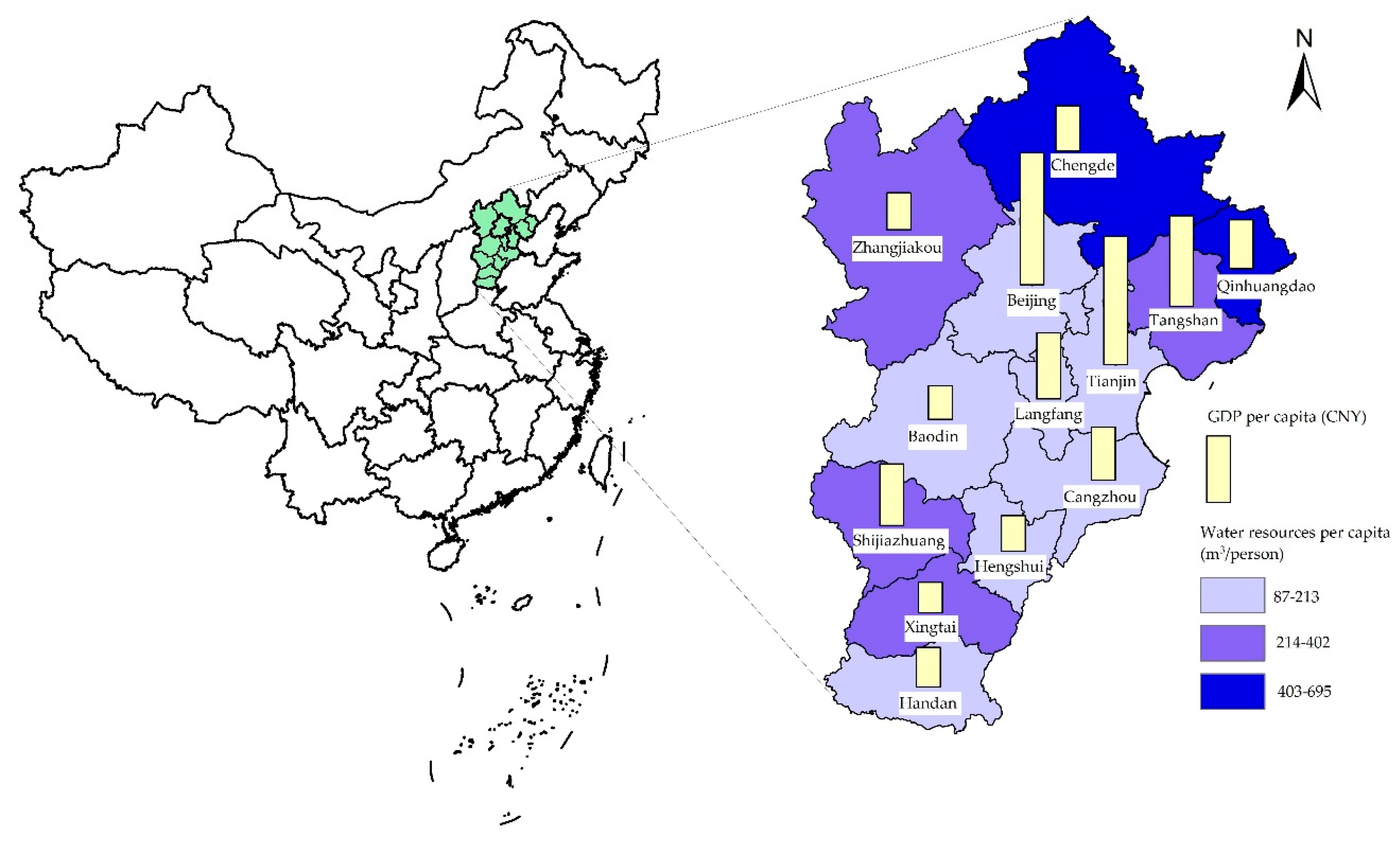
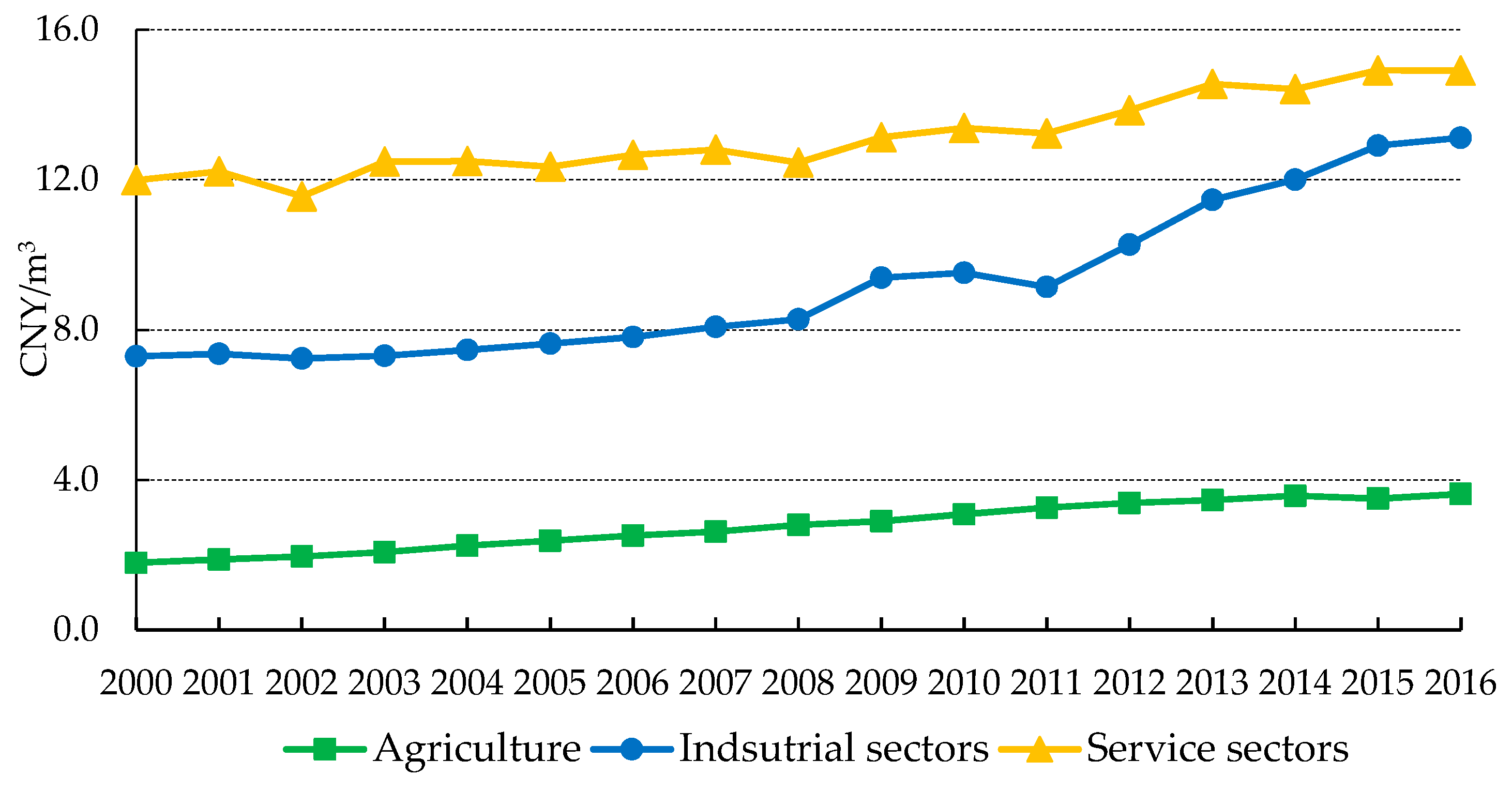
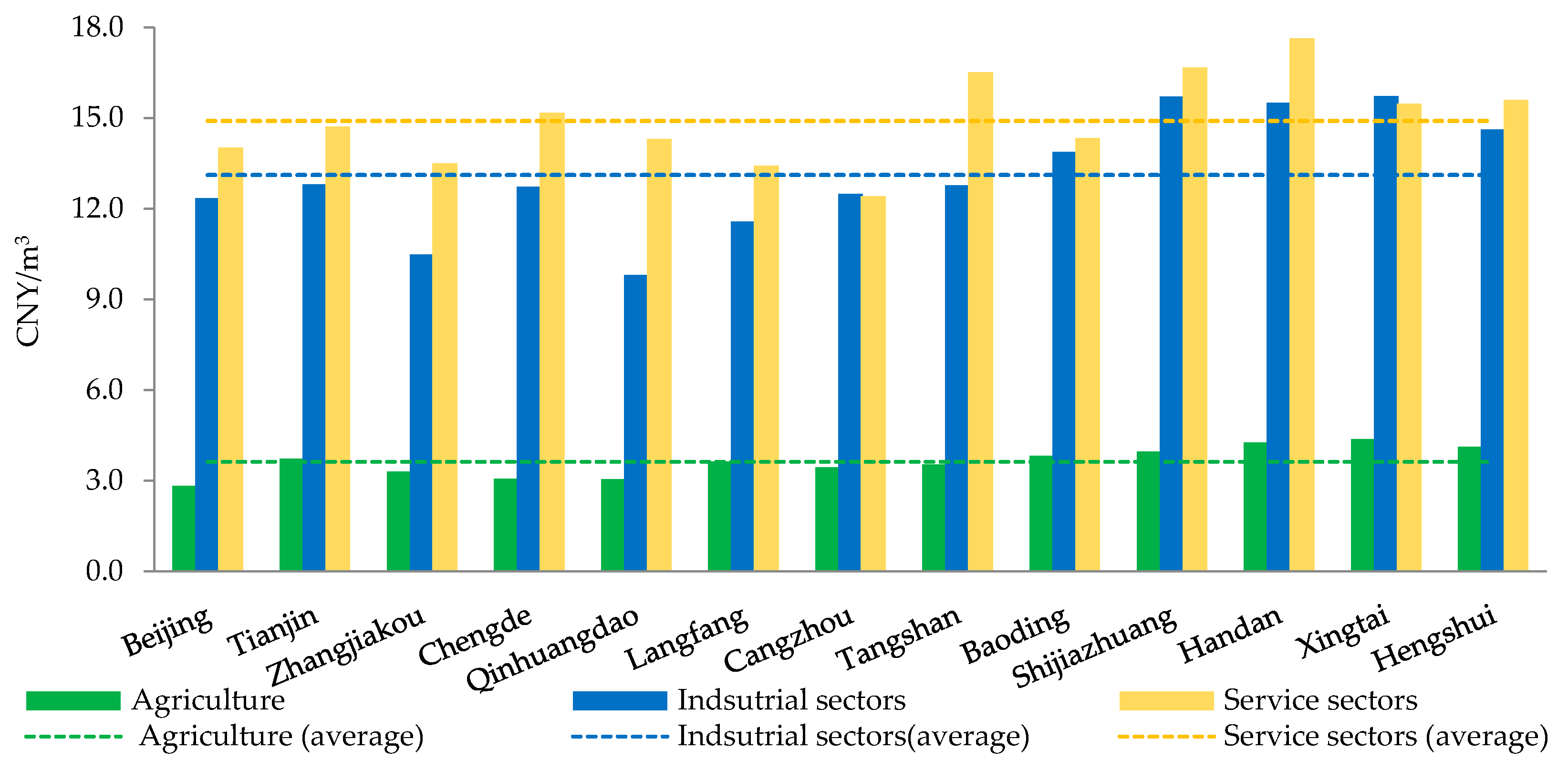

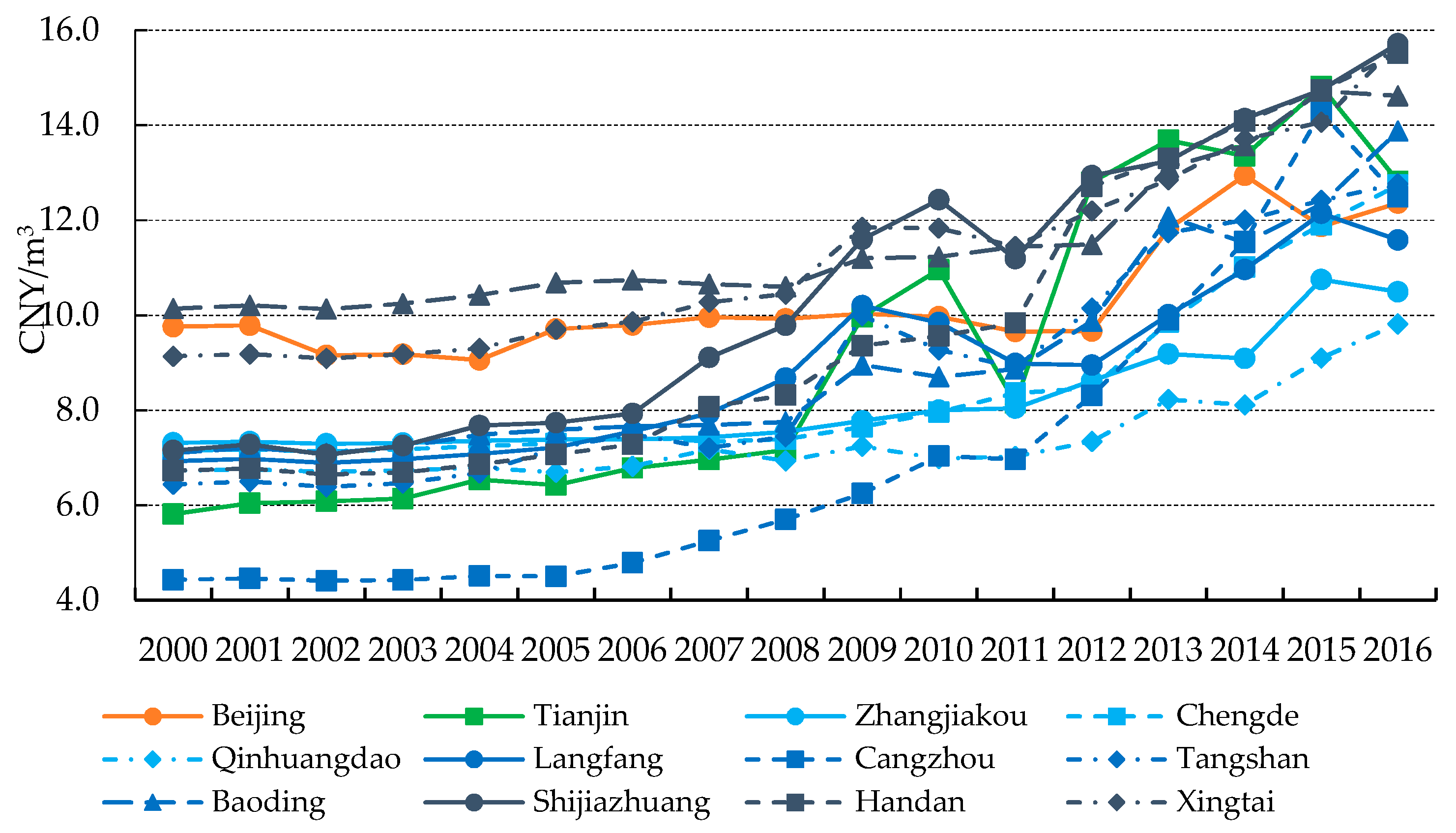
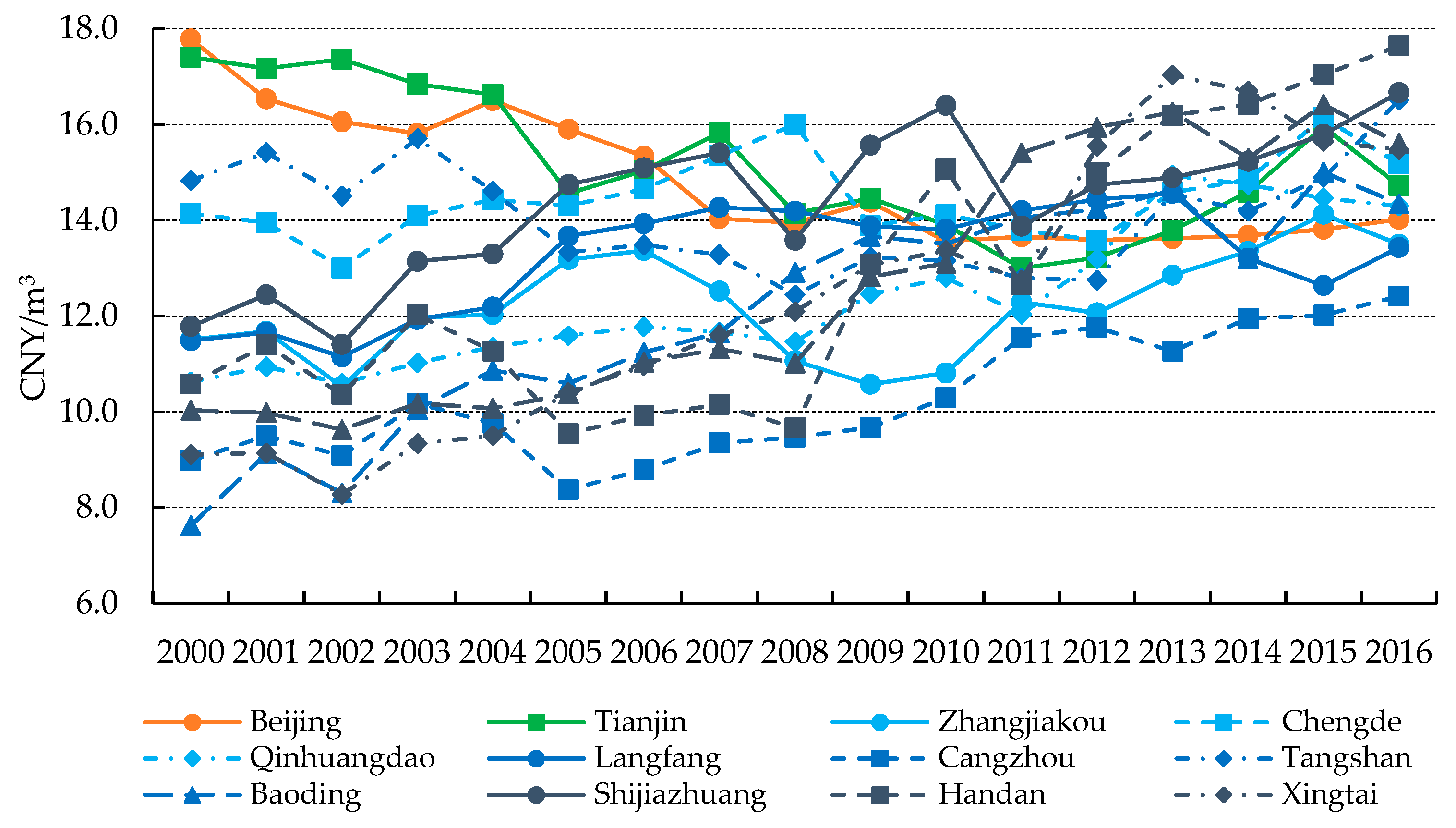
| Regions/Cities | Economic Condition | Water Endowment Condition | Water Use Condition | |||||||
|---|---|---|---|---|---|---|---|---|---|---|
| GDP Per Capita (CNY/person) | The Per Capita Net Income of Rural Residents (CNY) | The Per Capita Disposable Income of Urban Residents (CNY) | Total Water Resources (108m3) | Water Resources Per Capita (m3/person) | Residential Water Use Per Capita (m3/person) | Agricultural Water Use Per Capita (m3/person) | Industrial Water Use Per Capita (m3/person) | Services Water Use Per Capita (m3/person) | ||
| Beijing | - | 11813.2 | 22310.0 | 57275.0 | 35.1 | 161.5 | 34.1 | 44.9 | 23.7 | 43.2 |
| Tianjin | - | 11449.3 | 20076.0 | 37110.0 | 18.9 | 121.0 | 25.4 | 82.8 | 37.9 | 7.9 |
| Northern Hebei | Zhangjiakou | 3312.9 | 9241.0 | 26069.0 | 17.8 | 402.3 | 22.0 | 182.4 | 31.8 | 2.3 |
| Chengde | 4074.4 | 8736.0 | 24856.0 | 24.0 | 679.5 | 30.3 | 181.1 | 40.2 | 7.7 | |
| Qinhuangdao | 4359.2 | 11621.0 | 30348.0 | 21.5 | 694.8 | 29.6 | 197.6 | 51.1 | 7.6 | |
| Sub-total/average | 3693.7 | 8988.5 | 25462.5 | 41.8 | 540.9 | 26.8 | 186.2 | 39.8 | 5.5 | |
| Central Hebei | Langfang | 5893.8 | 14286.0 | 34633.0 | 7.1 | 153.9 | 28.7 | 150.5 | 33.5 | 6.0 |
| Cangzhou | 4723.2 | 11340.0 | 28605.0 | 6.5 | 86.6 | 22.3 | 136.4 | 27.7 | 1.8 | |
| Tangshan | 8102.1 | 15023.0 | 33725.0 | 22.4 | 285.6 | 32.5 | 207.2 | 79.0 | 14.2 | |
| Baoding | 2988.5 | 11612.0 | 25680.0 | 24.8 | 213.2 | 22.2 | 214.1 | 23.3 | 4.6 | |
| Sub-total/average | 5426.9 | 13065.3 | 30660.8 | 60.8 | 184.8 | 25.8 | 184.8 | 39.7 | 6.5 | |
| Southern Hebei | Shijiazhuang | 5496.7 | 12345.0 | 30459.0 | 32.0 | 296.7 | 28.7 | 224.4 | 34.6 | 7.1 |
| Handan | 3540.6 | 12153.0 | 26603.0 | 17.9 | 188.6 | 23.4 | 163.5 | 32.8 | 1.7 | |
| Xingtai | 2699.5 | 10006.0 | 23913.0 | 25.6 | 349.7 | 23.0 | 193.8 | 27.4 | 0.8 | |
| Hengshui | 3188.8 | 10069.0 | 23787.0 | 6.5 | 146.0 | 19.6 | 306.1 | 29.2 | 2.4 | |
| Sub-total/average | 3731.4 | 11143.3 | 26190.5 | 82.0 | 245.2 | 24.5 | 210.7 | 31.7 | 3.4 | |
| Regional Total/Average | 5606.9 | 13099.8 | 31059.6 | 238.6 | 257.0 | 27.1 | 152.2 | 34.1 | 12.7 | |
| Sectors | Variable | Unit | Maximum | Minimum | Mean | Standard Deviation |
|---|---|---|---|---|---|---|
| Agriculture | Capital | Billion CNY | 16.48 | 0.12 | 3.06 | 34.36 |
| Labor | Ten thousand people | 298.21 | 45.18 | 131.54 | 56.90 | |
| Water | Billion ton | 2.87 | 0.40 | 1.32 | 6.06 | |
| Value added | Billion CNY | 29.30 | 2.66 | 11.73 | 65.04 | |
| Industry | Capital | Billion CNY | 179.06 | 2.12 | 35.41 | 362.02 |
| Labor | Ten thousand people | 268.58 | 16.04 | 92.32 | 61.46 | |
| Water | Billion ton | 1.05 | 0.07 | 0.28 | 1.88 | |
| Value added | Billion CNY | 105.17 | 5.87 | 32.33 | 280.24 | |
| Services | Capital | Billion CNY | 360.57 | 2.43 | 43.56 | 610.55 |
| Labor | Ten thousand people | 1045.38 | 50.35 | 195.62 | 190.52 | |
| Water | Billion ton | 1.01 | 0.02 | 0.16 | 2.08 | |
| Value added | Billion CNY | 420.16 | 7.52 | 53.62 | 862.01 |
| Parameters | Agriculture | Industry | Services |
|---|---|---|---|
| α | −0.0680 | 0.0341 | −0.1223 |
| α1 | 0.0281 | 0.0256 | 0.0000 |
| α2 | 0.0000 | 0.0000 | 0.2916 |
| β1 | −0.2390 | −0.4290 | −0.3369 |
| γ1 | 0.7610 | 0.5710 | 0.6631 |
| α11 | −0.0217 | −0.0225 | −0.0001 |
| α12 | 0.0000 | 0.0000 | 0.0004 |
| α21 | 0.0000 | 0.0000 | 0.0004 |
| α22 | 0.0000 | 0.0000 | −0.2091 |
| β2 | −0.0771 | 0.0081 | −0.0972 |
| γ2 | −0.0771 | 0.0081 | −0.0972 |
| η1 | 0.0359 | 0.0692 | −0.0001 |
| η2 | 0.0000 | 0.0000 | 0.1313 |
| δ1 | 0.0359 | 0.0692 | −0.0001 |
| δ2 | 0.0000 | 0.0000 | 0.1313 |
| μ | −0.0771 | 0.0081 | −0.0972 |
| Cities/Regions | Optimal GDP with Water Constraints | Optimal GDP without Water Constraints | Potential Decline in Optimal GDP (%) | |
|---|---|---|---|---|
| Beijing | 1795.38 | 1884.33 | 4.95% | |
| Tianjin | 1288.83 | 1322.24 | 2.59% | |
| Hebei | 2668.59 | 2816.26 | 5.53% | |
| Northern Hebei | Zhangjiakou | 122.32 | 126.45 | 3.38% |
| Chengde | 117.26 | 122.61 | 4.56% | |
| Qinhuangdao | 113.12 | 114.57 | 1.28% | |
| Sub-total | 352.70 | 363.63 | 3.10% | |
| Central Hebei | Langfang | 175.32 | 182.13 | 3.88% |
| Cangzhou | 280.20 | 295.54 | 5.47% | |
| Tangshan | 584.40 | 618.65 | 5.86% | |
| Baoding | 271.00 | 288.98 | 6.64% | |
| Sub-total | 1310.92 | 1385.30 | 5.67% | |
| Southern Hebei | Shijiazhuang | 448.11 | 475.96 | 6.21% |
| Handan | 304.21 | 324.90 | 6.80% | |
| Xingtai | 152.35 | 160.98 | 5.67% | |
| Hengshui | 100.30 | 105.47 | 5.16% | |
| Sub-total | 1004.97 | 1067.32 | 6.20% | |
| Regional total | 5752.80 | 6022.82 | 4.69% | |
| Cities/Regions | Agriculture | Industry | Services | ||||
|---|---|---|---|---|---|---|---|
| Water Constraint | Without Water Constraint | Water Constraint | Without Water Constraint | Water Constraint | Without Water Constraint | ||
| Beijing | 14.5 | 15.8 | 337.1 | 350.2 | 1443.8 | 1518.3 | |
| Tianjin | 16.6 | 17.7 | 612.3 | 620.2 | 659.9 | 684.4 | |
| Heibei | 312.8 | 327.0 | 1268.5 | 1319.0 | 1087.3 | 1170.3 | |
| Northern Hebei | Zhangjiakou | 19.5 | 20.1 | 44.2 | 45.3 | 58.6 | 61.0 |
| Chengde | 17.6 | 18.3 | 55.4 | 57.7 | 44.3 | 46.6 | |
| Qinhuangdao | 14.4 | 14.6 | 37.6 | 38.3 | 61.0 | 61.7 | |
| Sub-total | 51.5 | 53.0 | 137.2 | 141.4 | 163.9 | 169.3 | |
| Central Hebei | Langfang | 19.0 | 19.9 | 82.5 | 84.4 | 73.8 | 77.8 |
| Cangzhou | 30.9 | 32.4 | 133.8 | 137.6 | 115.5 | 125.5 | |
| Tangshan | 51.1 | 53.1 | 324.4 | 333.4 | 208.9 | 232.1 | |
| Baoding | 36.7 | 38.6 | 125.9 | 133.9 | 108.3 | 116.5 | |
| Sub-total | 137.7 | 144.1 | 666.7 | 689.3 | 506.6 | 551.9 | |
| Southern Hebei | Shijiazhuang | 43.3 | 45.0 | 199.4 | 209.7 | 205.4 | 221.2 |
| Handan | 39.0 | 42.1 | 141.6 | 148.8 | 123.6 | 134.0 | |
| Xingtai | 23.2 | 24.1 | 76.2 | 79.7 | 53.0 | 57.1 | |
| Hengshui | 18.1 | 18.7 | 47.4 | 50.2 | 34.8 | 36.6 | |
| Sub-total | 123.5 | 129.9 | 464.6 | 488.4 | 416.8 | 449.0 | |
| Regional total | 343.9 | 360.4 | 2217.9 | 2289.4 | 3191.1 | 3373.0 | |
| Regions | Cities | 2007 | 2008 | 2009 | 2010 | 2011 | 2012 | 2013 | 2014 | 2015 | 2016 |
|---|---|---|---|---|---|---|---|---|---|---|---|
| Beijing | 1.8 | 1.8 | 1.8 | 1.6 | 1.6 | 1.6 | 1.9 | 1.5 | 1.2 | 1.2 | |
| Tianjin | 0.9 | 1.0 | 1.5 | 1.5 | 1.1 | 1.6 | 1.7 | 1.7 | 1.9 | 1.6 | |
| Northern Hebei | Zhangjiakou | 1.8 | 1.8 | 1.9 | 2.0 | 2.0 | 2.1 | 2.2 | 2.2 | 2.6 | 2.6 |
| Chengde | 1.3 | 1.3 | 1.4 | 1.4 | 1.5 | 1.5 | 1.8 | 2.0 | 2.1 | 2.3 | |
| Qinhuangdao | 2.3 | 2.2 | 2.3 | 1.2 | 1.2 | 1.2 | 1.4 | 1.3 | 1.5 | 1.6 | |
| Average | 1.7 | 1.7 | 1.8 | 1.5 | 1.5 | 1.6 | 1.7 | 1.8 | 2.0 | 2.1 | |
| Central Hebei | Langfang | 1.6 | 1.7 | 2.0 | 1.9 | 1.8 | 1.8 | 2.0 | 2.1 | 2.4 | 2.3 |
| Cangzhou | 1.1 | 1.2 | 1.3 | 1.1 | 1.1 | 1.3 | 1.6 | 1.8 | 2.3 | 2.0 | |
| Tangshan | 2.1 | 2.2 | 2.2 | 1.6 | 1.5 | 1.7 | 2.0 | 2.1 | 2.1 | 2.2 | |
| Baoding | 3.5 | 2.3 | 2.1 | 2.0 | 2.1 | 2.3 | 2.8 | 2.7 | 2.9 | 3.3 | |
| Average | 1.8 | 1.8 | 1.9 | 1.6 | 1.6 | 1.7 | 2.0 | 2.1 | 2.4 | 2.4 | |
| Southern Hebei | Shijiazhuang | 2.5 | 2.4 | 2.6 | 2.8 | 2.5 | 2.9 | 2.9 | 3.1 | 3.3 | 3.6 |
| Handan | 1.7 | 1.8 | 2.0 | 2.0 | 2.0 | 2.6 | 2.8 | 3.0 | 3.1 | 3.4 | |
| Xingtai | 3.3 | 3.4 | 3.7 | 2.0 | 2.0 | 2.1 | 2.2 | 2.4 | 2.4 | 2.7 | |
| Hengshui | 4.3 | 3.1 | 3.3 | 3.3 | 3.4 | 3.4 | 3.9 | 4.0 | 4.3 | 4.3 | |
| Average | 2.7 | 2.6 | 2.8 | 2.4 | 2.4 | 2.7 | 2.9 | 3.0 | 3.2 | 3.4 | |
| Regional average | 1.9 | 1.9 | 2.0 | 1.8 | 1.7 | 1.9 | 2.1 | 2.2 | 2.3 | 2.3 | |
| Regions | Cities | 2007 | 2008 | 2009 | 2010 | 2011 | 2012 | 2013 | 2014 | 2015 | 2016 |
|---|---|---|---|---|---|---|---|---|---|---|---|
| Beijing | 1.9 | 1.8 | 2.0 | 1.7 | 1.7 | 1.7 | 1.6 | 1.0 | 0.9 | 0.9 | |
| Tianjin | 2.1 | 1.9 | 2.1 | 1.8 | 1.7 | 1.6 | 1.7 | 1.8 | 2.0 | 1.8 | |
| Northern Hebei | Zhangjiakou | 2.5 | 2.2 | 2.2 | 2.2 | 2.5 | 2.5 | 2.6 | 2.7 | 2.9 | 2.7 |
| Chengde | 2.1 | 2.2 | 1.9 | 1.9 | 1.9 | 1.9 | 2.0 | 2.0 | 2.2 | 2.0 | |
| Qinhuangdao | 2.3 | 2.3 | 2.4 | 2.0 | 1.9 | 2.1 | 2.3 | 2.3 | 2.3 | 2.2 | |
| Average | 2.3 | 2.2 | 2.1 | 2.0 | 2.0 | 2.1 | 2.3 | 2.3 | 2.4 | 2.3 | |
| Central Hebei | Langfang | 1.7 | 1.8 | 1.7 | 1.7 | 1.8 | 1.8 | 1.8 | 1.6 | 1.6 | 1.7 |
| Cangzhou | 1.3 | 1.2 | 1.3 | 1.6 | 1.8 | 1.9 | 1.8 | 1.9 | 1.9 | 1.9 | |
| Tangshan | 2.5 | 2.3 | 2.4 | 2.2 | 2.2 | 2.2 | 2.5 | 2.4 | 2.5 | 2.8 | |
| Baoding | 3.3 | 1.4 | 3.1 | 3.1 | 3.2 | 3.3 | 3.4 | 3.1 | 3.5 | 3.3 | |
| Average | 2.1 | 1.6 | 2.0 | 2.1 | 2.1 | 2.2 | 2.2 | 2.1 | 2.2 | 2.3 | |
| Southern Hebei | Shijiazhuang | 3.3 | 2.8 | 2.8 | 3.0 | 2.5 | 2.7 | 2.7 | 2.7 | 2.8 | 3.0 |
| Handan | 1.7 | 1.7 | 2.2 | 3.0 | 2.5 | 3.0 | 3.2 | 3.3 | 3.4 | 3.5 | |
| Xingtai | 2.3 | 2.4 | 2.5 | 2.3 | 2.2 | 2.6 | 2.9 | 2.6 | 2.4 | 2.4 | |
| Hengshui | 2.1 | 1.5 | 1.8 | 1.8 | 2.1 | 2.2 | 2.2 | 1.8 | 2.0 | 1.9 | |
| Average | 2.3 | 2.0 | 2.3 | 2.4 | 2.3 | 2.6 | 2.7 | 2.5 | 2.6 | 2.6 | |
| Regional average | 2.2 | 1.9 | 2.1 | 2.1 | 2.1 | 2.2 | 2.3 | 2.1 | 2.1 | 2.1 | |
© 2019 by the authors. Licensee MDPI, Basel, Switzerland. This article is an open access article distributed under the terms and conditions of the Creative Commons Attribution (CC BY) license (http://creativecommons.org/licenses/by/4.0/).
Share and Cite
Li, Y.; Zhang, Z.; Shi, M. Restrictive Effects of Water Scarcity on Urban Economic Development in the Beijing-Tianjin-Hebei City Region. Sustainability 2019, 11, 2452. https://doi.org/10.3390/su11082452
Li Y, Zhang Z, Shi M. Restrictive Effects of Water Scarcity on Urban Economic Development in the Beijing-Tianjin-Hebei City Region. Sustainability. 2019; 11(8):2452. https://doi.org/10.3390/su11082452
Chicago/Turabian StyleLi, Yuanjie, Zhuoying Zhang, and Minjun Shi. 2019. "Restrictive Effects of Water Scarcity on Urban Economic Development in the Beijing-Tianjin-Hebei City Region" Sustainability 11, no. 8: 2452. https://doi.org/10.3390/su11082452
APA StyleLi, Y., Zhang, Z., & Shi, M. (2019). Restrictive Effects of Water Scarcity on Urban Economic Development in the Beijing-Tianjin-Hebei City Region. Sustainability, 11(8), 2452. https://doi.org/10.3390/su11082452





